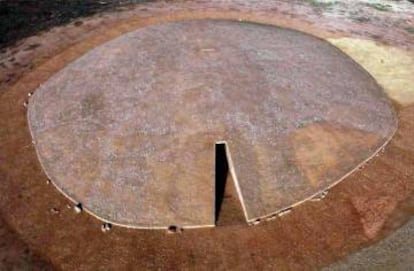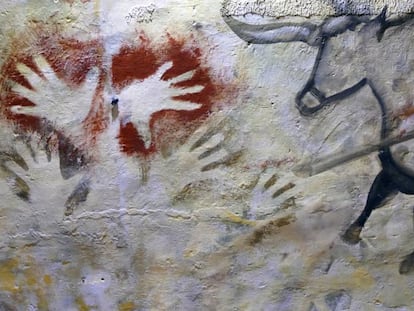How an underground Stonehenge was discovered in southern Spain
A joint investigation between six universities is shining a light on the Dolmen de Soto, a 6,000-year-old megalithic monument, complete with ancient drawings of armed figures

In 1923, a bricklayer named Manuel Guijarro, who was building a cabin for the guard on Marquis Armando de Soto’s La Lobita estate, discovered huge, rare stones in an area known as Zancarrón, in the municipality of Trigueros (Huelva) in southwestern Spain. After examining the stones for himself, De Soto ordered the site to be excavated and sent a report with the findings to the Royal Academy of History in Madrid.
If it had been located in the United Kingdom, it would already be one of the most-visited tourist sites Mimi Bueno-Ramírez, prehistorian at Alcalá de Henares University
Nearly a century later, with the help of modern technology, experts from five Spanish universities and an American one have shed light on the mysterious finding. According to the experts, the stones belong to a 6,000-year-old dolmen that was buried beneath a mound 60 meters in diameter. The stones are decorated with more than 60 drawings of figures carrying axes, staffs and daggers. Many of the figures are represented by geometric red-and-black drawings, set against a white background.
“If it had been located in the United Kingdom, for example, it would already be one of the most visited tourist sites. It is simply spectacular,” says Mimi Bueno-Ramírez, a professor of prehistory at Alcalá de Henares University in Madrid.
The discovery of the prehistoric Altamira cave paintings in Spain, which were only internationally recognized in 1902, drew the attention of some of Europe’s best archaeologists in the early 20th century. Among the number of experts drawn to Spain in the hopes of finding their own El Dorado was the German prehistorian Hugo Obermaier, who was asked by the Spanish Royal Academy of History to study the stones found on De Soto’s property. In 1924, Obermaier published a book that quickly became a benchmark text on one of the most well-known megalithic monuments in European specialized literature, even though it remained largely unknown to the general public.

Three years ago, the universities of Alcalá, Huelva, Sevilla, Castilla-La Mancha, UNED (Spain’s long-distance learning university) and the University of Texas in Austin decided to collaborate together and use more advanced technologies on the monument.
The results indicate that the megalithic complex is covered by a large mound about 60 meters in diameter, and is surrounded by a circle of stones with a diameter of 65 meters. Inside there is gallery made up of 63 stone pillars, a frontal slab and 30 other stones that cover it. An underground passage, measuring 21.5 meters, starts off narrow then widens to three meters in width and height as it reaches the back of the monument. All of the stones are engraved, carved or painted, according to a study in the book Symbols of death in the recent prehistory of southern Europe: the dolmen of Soto, published by the regional government of Andalusia.
“They dismantled a previous circle [as happened with Stonehenge in England] and transported it to the interior of the mound. We don’t know their reasons, but the most plausible one is that it [the dolmen] was the center of a large necropolis,” explains Bueno-Ramírez.
The stones, which were taller than the mound, were broken and chiselled down so they could fit underground. “The most striking case is the head stone. It appeared very fragmented near the top, some of the ancient drawings were even cut off. We managed to show that this stone must have been around six meters tall,” says Bueno-Ramírez. The dolmen is surrounded by a circle of fragmented stones, and excavations have confirmed that this ring is older than the actual dolmen. Stone supports were extracted from this circle for the underground construction.

Using carbon dating, experts have dated the monument back to the 4th millennium BC. The stones that form the underground passage are decorated with striking red paint, which dates back to the period in which the first stone circle was made. However, when the new dolmen was created, the Neolithic population repainted them and started to draw armed figures.
“There is not a single megalithic monument in Europe that has so many armed figures on its walls,” says Bueno-Ramírez. Indeed the complex features two rows of painted figures that, according to the prehistorian, are “a unique exhibition of drawn weapons.” Inside the mound, experts have found a metalworking workshop dating back to 3,000 BC, which indicates that the drawings of the weapons coincided with the discovery of metallurgy.
Another exceptional discovery is the presence of a figure holding a Carp’s Tongue sword, a type of weapon typical of the Late Bronze Age and of the Tartessos culture. Bueno-Ramírez believes that the more recent inhabitants of the complex were interested in putting their mark on the ancient monument “to reinforce their prestige.”
Experts have also found human remains. Obermaier discovered eight bodies and their belongings, which he handed over to Marquis De Soto, who took them to the United Kingdom. It is not known where they went from there. “It is a pity because they were never able to be analyzed,” says Bueno-Ramírez.
English version by Asia London Palomba.
Tu suscripción se está usando en otro dispositivo
¿Quieres añadir otro usuario a tu suscripción?
Si continúas leyendo en este dispositivo, no se podrá leer en el otro.
FlechaTu suscripción se está usando en otro dispositivo y solo puedes acceder a EL PAÍS desde un dispositivo a la vez.
Si quieres compartir tu cuenta, cambia tu suscripción a la modalidad Premium, así podrás añadir otro usuario. Cada uno accederá con su propia cuenta de email, lo que os permitirá personalizar vuestra experiencia en EL PAÍS.
¿Tienes una suscripción de empresa? Accede aquí para contratar más cuentas.
En el caso de no saber quién está usando tu cuenta, te recomendamos cambiar tu contraseña aquí.
Si decides continuar compartiendo tu cuenta, este mensaje se mostrará en tu dispositivo y en el de la otra persona que está usando tu cuenta de forma indefinida, afectando a tu experiencia de lectura. Puedes consultar aquí los términos y condiciones de la suscripción digital.











































